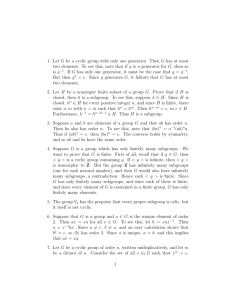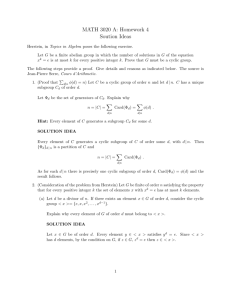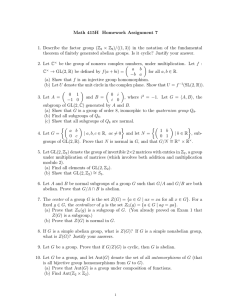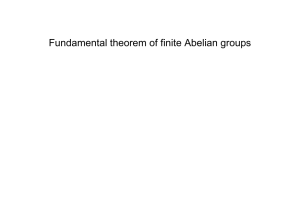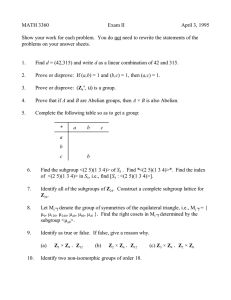Groups whose subgroups have distinct cardinalities Greg Oman February 15, 2014
advertisement
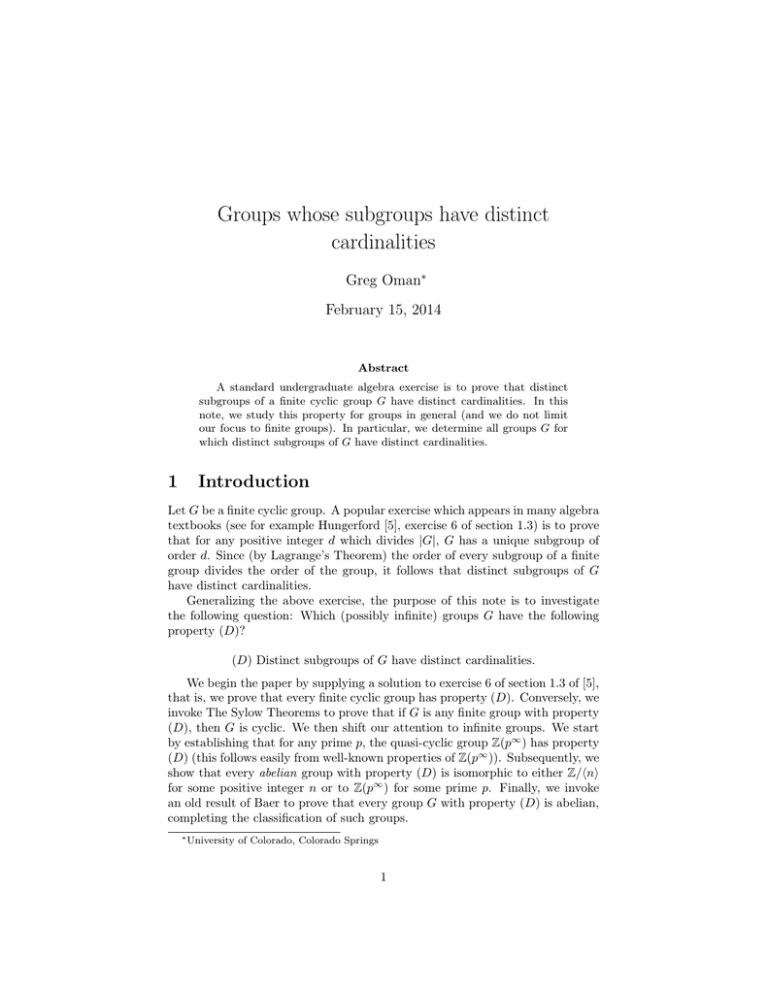
Groups whose subgroups have distinct
cardinalities
Greg Oman∗
February 15, 2014
Abstract
A standard undergraduate algebra exercise is to prove that distinct
subgroups of a finite cyclic group G have distinct cardinalities. In this
note, we study this property for groups in general (and we do not limit
our focus to finite groups). In particular, we determine all groups G for
which distinct subgroups of G have distinct cardinalities.
1
Introduction
Let G be a finite cyclic group. A popular exercise which appears in many algebra
textbooks (see for example Hungerford [5], exercise 6 of section 1.3) is to prove
that for any positive integer d which divides |G|, G has a unique subgroup of
order d. Since (by Lagrange’s Theorem) the order of every subgroup of a finite
group divides the order of the group, it follows that distinct subgroups of G
have distinct cardinalities.
Generalizing the above exercise, the purpose of this note is to investigate
the following question: Which (possibly infinite) groups G have the following
property (D)?
(D) Distinct subgroups of G have distinct cardinalities.
We begin the paper by supplying a solution to exercise 6 of section 1.3 of [5],
that is, we prove that every finite cyclic group has property (D). Conversely, we
invoke The Sylow Theorems to prove that if G is any finite group with property
(D), then G is cyclic. We then shift our attention to infinite groups. We start
by establishing that for any prime p, the quasi-cyclic group Z(p∞ ) has property
(D) (this follows easily from well-known properties of Z(p∞ )). Subsequently, we
show that every abelian group with property (D) is isomorphic to either Z/hni
for some positive integer n or to Z(p∞ ) for some prime p. Finally, we invoke
an old result of Baer to prove that every group G with property (D) is abelian,
completing the classification of such groups.
∗ University
of Colorado, Colorado Springs
1
In the final section, we examine some properties related to property (D),
and show that there is a sense in which our work is very difficult to generalize.
Specifically, let G be a group. Say that G has property (L) if the subgroups
of G are linearly ordered under set-theoretic inclusion, property (C) if every
subgroup of G is characteristic1 in G, and property (N ) if every subgroup of G
is normal in G. Now consider the following conditions:
(1)
(2)
(3)
(4)
G
G
G
G
has
has
has
has
property
property
property
property
(L).
(D).
(C).
(N ).
We show that (1) ⇒ (2) ⇒ (3) ⇒ (4) but that none of the implications can
be reversed. We supply plausibility arguments showing that the problems of
classifying the groups in (3) or (4) seem to be quite difficult. We then conclude
the paper by rederiving the classical characterization of the groups which satisfy
(1).
2
Finite cyclic groups have property (D)
As mentioned in the introduction, it is well-known that if G is a finite cyclic
group, then distinct subgroups of G have distinct cardinalities (cf. [5], exercise
6 of section 1.3 and Lang [6], p. 24), that is, G has property (D). We begin the
body of the paper by sketching a short proof of this fact.
Proposition 1. Let G be a finite cyclic group. Then distinct subgroups of G
have distinct cardinalities.
Proof. Let G := hgi be a finite cyclic group of order m, and let H be a subgroup
of G. Then H is cyclic, whence H = hg k i for some k with 1 ≤ k ≤ m. Now let
d :=gcd(k, m). We claim that hg k i = hg d i. Since d|k, the inclusion hg k i ⊆ hg d i
is clear. To prove the reverse implication, recall that αk + βm = d for some
integers α and β. Hence m|(d − αk). We conclude that g d = (g k )α , and hence
hg d i ⊆ hg k i.
To finish the proof, we suppose that H and K are subgroups of G of the
same cardinality. We will show that H = K. By our work above, it follows
that H = hg d1 i and K = hg d2 i for some positive integers d1 and d2 which divide
m. Thus |H| = |hg d1 i| = dm1 = |K| = dm2 . We deduce that d1 = d2 , and thus
H = K.
3
All finite groups with property (D) are cyclic
Let G be a finite group. In the previous section, we prove that if G is cyclic, then
G has property (D). We now establish the converse (which is a deeper result)
1 Recall that a subgroup H of G is a characteristic subgroup of G if and only if ϕ[H] = H
for every automorphism ϕ of G.
2
via the Sylow Theorems. We begin by recalling that if p is a prime which divides
the order of G, then a subgroup H of G is said to be a Sylow p-subgroup of G
provided |H| = pm for some non-negative integer m and pm+1 does not divide
|G|. We now recall Sylow’s famous results (for a proof, see Theorem 6.4, pp.
34-35 of [6]. We will not have occasion to make use of (3) below, but we list it
for the sake of completeness.):
Proposition 2 (The Sylow Theorems). Let G be a finite group, and suppose
that p is a prime which divides the order of G. Then:
(1) Every subgroup of G whose order is a power of p is contained in some
Sylow p-subgroup of G.
(2) All Sylow p-subgroups of G are conjugate (that is, if H and K are Sylow
p-subgroups of G, then there exists some g ∈ G such that K = gHg −1 ).
(3) Let np be the number of Sylow p-subgroups of G. Then np ≡ 1 mod p.
It is easy to see that (2) implies that a Sylow p-subgroup H of G is normal
if and only if it is unique.
We will soon be able to prove the assertion made in the title of this section.
We first prove a lemma and then recall a fact from the literature.
Lemma 1. Suppose that G is a group (which may be infinite) which satisfies
property (D) (we remind the reader that this means that distinct subgroups of G
have distinct cardinalities). Then every subgroup of G is normal.
Proof. Assume that G is a group which has property (D), and let H be an
arbitrary subgroup of G. We will prove that H is normal. Toward this end, let
g ∈ G be arbitrary. Now note that gHg −1 := {ghg −1 : g ∈ H} is a subgroup
of G and that H ∼
= gHg −1 (this can be seen via that map ϕ : H → gHg −1
defined by ϕ(h) := ghg −1 ). Thus |H| = |gHg −1 |. Since G has property (D),
we conclude that H = gHg −1 , whence H is normal in G.
Fact 1 (See [5], p. 96). Let G be a finite group, and assume that for every p
dividing the order of G, every Sylow p-subgroup of G is normal (whence by the
comment following Proposition 2, unique). Then G is the direct product of its
Sylow p-subgroups.
We now prove that every finite group with property (D) is cyclic. We would
not be surprised if the following result is in the literature, but a quick check of
the standard texts [4]–[6] did not reveal it.
Proposition 3. Let G be a finite group with property (D). Then G is cyclic.
Proof. Assume that G is a finite group and that G has property (D). If G
is trivial, then of course G is cyclic and we are done. Thus, suppose that G is
nontrivial, and let |G| = pn1 1 pn2 2 · · · pnk k be the prime factorization of |G|. Lemma
1 yields that every Sylow pi -subgroup of G is normal in G, whence is unique.
For each i, 1 ≤ i ≤ k, let Gi be the Sylow pi -subgroup of G. Fact 1 gives us
that
3
G = G1 × G2 × · · · × Gk .
(1)
Now fix an i with 1 ≤ i ≤ k. We will prove that Gi is cyclic. Without loss
of generality, we may assume that i = 1. Recall from above that |G1 | = pn1 1 ;
for simplicity, we set p := p1 and n := n1 . Suppose by way of contradiction
that G1 is not cyclic. Then clearly G1 is the union of its proper subgroups.
Let {H1 , H2 , . . . , Hs } be the collection of proper subgroups of G1 . For each i
satisfying 1 ≤ i ≤ s, it follows from Lagrange’s Theorem that |Hi | = pj for some
integer j satisfying 0 ≤ j < n. As G has property (D), clearly so does G1 . We
conclude that for each j with 0 ≤ j < n, G1 has at most one subgroup of order
pj (in fact, G1 has a subgroup of order pj for every j satisfying 0 ≤ j ≤ n, but
we do not need this fact). We deduce that
|G1 | = |H1 ∪ H2 ∪ · · · ∪ Hs | ≤ 1 + p + p2 + · · · + pn−1 =
pn − 1
< pn = |G1 |,
p−1
and we have reached a contradiction. Thus G1 is cyclic, and we have
n
n
G∼
= Z/hpn1 1 i × Z/hpn2 2 i × · · · × Z/hpk k i ∼
= Z/hpn1 1 pn2 2 · · · pk k i,
(2)
whence G is cyclic (the final isomorphism is a direct result of The Chinese
Remainder Theorem; see also [6], p. 24). This completes the proof.
4
A class of infinite groups with property (D)
As the title of this section indicates, we will display an infinite collection of
groups which have property (D). These groups are the so-called quasi-cyclic
groups, and they are defined as follows.
Definition 1. Let p be a prime. Then the quasi-cyclic group of type p∞ , denoted
Z(p∞ ), is the subgroup of Q/Z defined by:
a
: a ∈ Z, n ∈ Z+ }.
pn
These groups play a fundamental and important role in abelian group theory,
and we will have more to say about them later. For now, we are interested in
establishing that every quasi-cyclic group Z(p∞ ) has property (D). We begin
with a lemma (the following properties of the quasi-cyclic groups are well-known;
see Fuchs [3], pp. 23-25. We present a proof for completeness.).
Z(p∞ ) := {Z +
Lemma 2. Let p be a prime. Then the following hold:
(1) Z(p∞ ) is infinite.
(2) Every element of Z(p∞ ) has finite order.
(3) For any x, y ∈ Z(p∞ ), either hxi ⊆ hyi or hyi ⊆ hxi (hence the subgroups
of Z(p∞ ) are linearly ordered by inclusion).
(4) Every proper subgroup of Z(p∞ ) is finite2 .
2 In
fact, every proper subgroup of Z(p∞ ) is cyclic of cardinality a power of p.
4
Proof. Let p be a prime.
(1) It is readily checked that for distinct positive integers i and j, Z +
Z + p1j .
(2) Consider an arbitrary element x := Z +
that pn x = 0, and (2) is proved.
a
pn
1
pi
6=
∈ Z(p∞ ). Then simply note
(3) Let x, y ∈ Z(p∞ ) be arbitrary. We will prove that either hxi ⊆ hyi or
hyi ⊆ hxi. If either x = 0 or y = 0, the result is patent, so assume that x and y
are nonzero. Write x := Z + pam and y := Z + pbn where a, b ∈ Z are both prime
to p and m, n are positive integers. By elementary number theory, there exist
integers c, d, e, and f such that
ca + dpm = 1, and
(3)
eb + f pn = 1.
(4)
1−dp
Thus cx = Z + pca
m = Z +
pm
1
ey = Z + pn . We conclude that
m
= Z + ( p1m − d) = Z +
hxi = hZ +
1
pm .
Analogously,
1
i, and
pm
(5)
1
i.
pn
(6)
hyi = hZ +
Without loss of generality, assume that m ≤ n. Then simply note that Z+ p1m =
n−m
Z + p pn ∈ hyi (by (6) above), and thus hxi ⊆ hyi. We conclude that the
subgroups of Z(p∞ ) are linearly ordered by inclusion.
(4) Let H be a proper subgroup of Z(p∞ ). We will show that H is finite.
Toward this end, let x ∈ Z(p∞ ) − H. We conclude from (3) that H ⊆ hxi. It
now follows from (2) that H is finite.
We conclude this section by showing that the quasi-cyclic groups possess
property (D).
Proposition 4. Let p be a prime. Then the quasi-cyclic group Z(p∞ ) has
property (D).
Proof. Let H and K be subgroups of Z(p∞ ) of the same cardinality. We will
show that H = K. By (3) of Lemma 2, we may assume that H ⊆ K. Suppose
first that K is infinite. Since |H| = |K| and (by (4) of Lemma 2) all proper
subgroups of of Z(p∞ ) are finite, we deduce that H = K = Z(p∞ ). Suppose
now that K is finite. As H ⊆ K and |H| = |K|, we see that H = K, concluding
the proof.
5
5
A classification of all groups with property (D)
We have seen that every finite cyclic group as well as every quasi-cyclic group
has property (D). In this section, we will prove that these constitute all groups
with this property. We begin by settling the abelian case, and then we prove
that every group with property (D) is abelian.
Let p be a prime and let G be an abelian group. Then G is p-divisible
provided pG = G (that is, {pg : g ∈ G} = G). Moreover, G is divisible if
nG = G for every positive integer n. It is easy to check that G is divisible if
and only if G is p-divisible for every prime p. We will need the following lemma
(this is exercise 2 on p. 67 of [3]).
Lemma 3. Let G be an abelian group. Then G is either divisible or has a
maximal subgroup.
Proof. Suppose that G is an abelian group which is not divisible. We will prove
that G has a maximal subgroup. Since G is not divisible, there is some prime p
such that G is not p-divisible. Thus pG ( G. It follows that G/pG is a nonzero
vector space over the field Z/hpi, and hence we obtain the following sequence of
surjections:
G → G/pG → Z/hpi.
(7)
Composing, we get a surjective group homomorphism ϕ : G → Z/hpi. If K
is the kernel of this map, then G/K ∼
= Z/hpi. Since Z/hpi has exactly two
subgroups, it follows that there are exactly two subgroups of G containing K,
whence K is a maximal subgroup of G.
We will also make use of the following theorem, which describes the structure
of divisible abelian groups. (see [3], Theorem 19.1 for a proof).
Proposition 5 (Structure Theorem for Divisible Abelian Groups). Let G be an
abelian group. Then G is divisible if and only if there is a collection {Gi : i ∈ I}
of abelian groups such that
(1) For every i, either G = Q or G = Z(p∞ ) for some prime p.
L
(2) G ∼
= i∈I Gi .3
We now classify the abelian groups with property (D).
Proposition 6. Let G be an abelian group. Then G has property (D) if and
only if G is either a finite cyclic group or a quasi-cyclic group.
Proof. We saw in Proposition 1 and Proposition 4 that finite cyclic groups and
quasi-cyclic groups have property (D). Now let G be an arbitrary abelian group
with property (D). If G is finite, then G is cyclic by Proposition 3. Now assume
3 We
L
remind the reader that the direct sum
i∈I Gi is the group whose ground set is the
set of all sequence (gi : i ∈ I) with the property that gi ∈ Gi for each i and all but finitely
many of the gi are equal to 0. Further, (gi : i ∈ I) + (hi : i ∈ I) := (gi + hi : i ∈ I).
6
that G is infinite. We claim that G is divisible. If not, then Lemma 3 yields that
G has a maximal subgroup M . But then G/M is simple, whence G/M ∼
= Z/hpi
for some prime p. But then M has finite index in G. It follows from basic
cardinal arithmetic that |M | = |G|, contradicting that G has property (D). We
conclude thatL
G is divisible. By The Structure Theorem for Divisible Abelian
Groups, G ∼
= i∈I Gi , where for each i, Gi = Q or Gi = Z(p∞ ) for some prime
number p. We claim that |I| = 1. Otherwise, simply delete a summand, and we
obtain a proper subgroup H of G of the same cardinality as G, contradicting
that G has property (D). Hence |I| = 1, and G ∼
= Q or G ∼
= Z(p∞ ) for some
prime p. Clearly Q does not have property (D) (since Z is a proper infinite
subgroup of Q), whence G ∼
= Z(p∞ ) for some prime p.
To complete our classification, it suffices to show that every group with
property (D) is abelian. Toward this end, we employ a classical result of Baer
(whose proof is beyond the scope of this paper).
Proposition 7 (Baer [1]). Suppose that G is nonabelian and that every subgroup
of G is normal. Then there is a torsion abelian group P (that is, all elements of
P have finite order) with no elements of order 4 such that G ∼
= Q8 × P , where
Q8 is the quaternion group with 8 elements4 .
We conclude this section with the following theorem which, along with
Proposition 6, yields a complete description of the groups with property (D).
Theorem 1. Every group with property (D) is abelian. Thus a group G has
the property that distinct subgroups of G have distinct cardinalities if and only
if G is finite cyclic or quasi-cyclic.
Proof. Suppose by way of contradiction that G is a nonabelian group with
property (D). Then Lemma 1 tells us that every subgroup of G is normal. By
Baer’s result above, G ∼
= Q8 ×P for some group P . Since subgroups of G clearly
inherit property (D), we conclude that Q8 has property (D). But Q8 has three
subgroups of order 4 (namely {1, −1, i, −i}, {1, −1, j, −j}, and {1, −1, k, −k}),
and we have reached a contradiction.
We conclude the section by remarking that Baer’s result along with The
Fundamental Theorem of Finitely Generated Abelian Groups yields a very short
proof of Proposition 3. However, we find it interesting that an undergraduatelevel proof exists, which is why we included it in this paper.
6
Remarks on possible generalizations
The primary objective of the remainder of this paper is to illustrate difficulties
which arise if one attempts to generalize (in a natural way) the classification of
groups with property (D). To wit, let G be a group. Then (as stated in the
introduction) say that G has property (L) if the subgroups of G are linearly
4Q
8
is given by the presentation Q8 := h−1, i, j, k|(−1)2 = 1, i2 = j 2 = k2 = ijk = −1i.
7
ordered under set-theoretic inclusion, property (C) if every subgroup of G is
characteristic in G, and property (N ) if every subgroup of G is normal in G.
Now consider the following conditions:
(1)
(2)
(3)
(4)
G
G
G
G
has
has
has
has
property
property
property
property
(L).
(D).
(C).
(N ).
Then the following relationships hold:
Proposition 8. (1) ⇒ (2) ⇒ (3) ⇒ (4), but none of the implications can be
reversed.
Proof. Let G be a group.
(1) ⇒ (2): It is readily checked (as in the proof of Lemma 2) that if G has
property (L), then all proper subgroups of G are finite. It is now easy to see
that G has property (D). To see that the implication cannot be reversed, simply
note that Z/h6i has property (D) but not property (L) (since it has a subgroup
H of order 2 and a subgroup K of order 3; by Lagrange’s Theorem, K cannot
contain H).
(2) ⇒ (3): Suppose G has property (D). If ϕ : G → G is an automorphism
and H is a subgroup of G, simply note that |H| = |ϕ[H]|, whence H = ϕ[H]
since G has property (D), and we see that H is a characteristic subgroup of
G. The group Z(2∞ ) ⊕ Z(3∞ ) has property (C) but not property (D). That
Z(2∞ ) ⊕ Z(3∞ ) has property (C) follows quickly from the fact that Z(2∞ ) ⊕
Z(3∞ ) is a subgroup of Q/Z, and distinct subgroups of Q/Z are not isomorphic
(whence this property is inherited by Z(2∞ ) ⊕ Z(3∞ )); see [3], pp. 23-25 and p.
68, exercise 25 for further details.
(3) ⇒ (4): Suppose that G has property (C), and let H be a subgroup
of G. For any g ∈ G, the map ϕ : G → G defined by ϕ(x) := gxg −1 is
an automorphism of G. Since G has property (C), we conclude that ϕ(H) =
gHg −1 = H, whence H is normal in G. To see that the implication cannot be
reversed, simply consider the group G := Z/h2i × Z/h2i. As G is abelian, G has
property (N ), yet Z/h2i × {0} is not characteristic since it is not mapped into
itself via the automorphism (x, y) 7→ (y, x).
We now address the following (somewhat vague) question: Can our work
be generalized by classifying the groups in (3) or (4) above? At present, it
seems the answer is ‘no’. More specifically, note that every abelian group has
property (N ), and the class of abelian groups is much too monstrous to yield
to a classification theorem (even the subgroups of Q × Q are not completely
understood). But can we dispose of (3)? It turns out that there are examples of
abelian groups G with extremely complicated structure for which the inversion
map is the only non-trivial automorphism of G (see p. 592 of Cutolo, Smith,
and Wiegold [2], for example); any such group G clearly satisfies property (C).
8
So it seems that a classification of the groups in (3) is presently out of reach as
well.
We conclude the paper with a corollary which characterizes the quasi-cyclic
groups.
Corollary 1. Let G be an infinite group. Then the following are equivalent5 :
(1) G ∼
= Z(p∞ ) for some prime p.
(2) The subgroups of G are linearly ordered by inclusion.
(3) Distinct subgroups of G have distinct cardinalities.
Proof. Let G be an infinite group.
(1) ⇒ (2): See (3) of Lemma 2.
(2) ⇒ (3): This is the implication “(1) ⇒ (2)” of Proposition 8.
(3) ⇒ (1): Immediate from Theorem 1.
References
[1] R. Baer, Situation der untergruppen und struktur der gruppe, S. B. Heidelberg. Akad. Wiss., Vol. 2, pp 12–17, 1933.
[2] G. Cutolo, H. Smith, and J. Wiegold, Finiteness conditions on characteristic closures and cores of subgroups, J. Group Theory, Vol. 12, pp
591–610, 2009.
[3] Fuchs, L., “Abelian Groups”, Publishing House of the Hungarian Academy
of Sciences, Budapest, 1958.
[4] Herstein, I.N., “Topics in Algebra”, Blaisdell, Waltham, 1964.
[5] Hungerford, T., “Algebra”, Springer, New York, 1974.
[6] Lang, S., “Algebra. Revised third edition”, Graduate Texts in Mathematics, 211. Springer-Verlag, New York, 2002.
[7] Lotto, B., Stacked groups, Amer. Math. Monthly, Vol. 114, No. 9, pp
811–812, 2007.
About the author:
Greg Oman
Greg is an assistant professor of mathematics at The University of Colorado,
Colorado Springs. He works in a number of areas, but specializes in ring theory,
5 The equivalence of (1) and (2) is well-known; we refer the reader to Lotto [7] for a selfcontained proof.
9
semigroup theory, and universal algebra. Though he misses his family and
friends (and The Sweet!) back in Ohio, he is loving the beautiful mountains,
the 300 plus days of sunshine per year, and the lack of humidity.
University of Colorado, Colorado Springs, Colorado, 80918.
goman@uccs.edu
10

